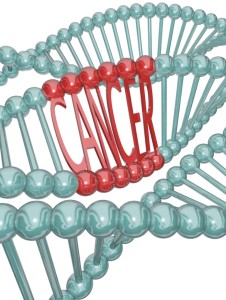 In 2012, Boston Children’s Hospital held the international CLARITY Challenge—an invitation to interpret genomic sequence data from three children with rare diseases and provide a meaningful, actionable report for clinicians and families. (Click for more background on the children, findings and winners.)
In 2012, Boston Children’s Hospital held the international CLARITY Challenge—an invitation to interpret genomic sequence data from three children with rare diseases and provide a meaningful, actionable report for clinicians and families. (Click for more background on the children, findings and winners.)
The full proceedings, published March 25 in Genome Biology, concluded that while the technical approaches were markedly similar from center to center, the costs, efficiency and scalability were not. Most variable, and most in need of future work, was the quality of the clinical reporting and patient consenting process. The exercise also underscored the need for medical expertise to bring meaning to the genomic data.
That was CLARITY 1. CLARITY 2, focusing on cancer genomics in children, promises to be exponentially more complex. Full story »
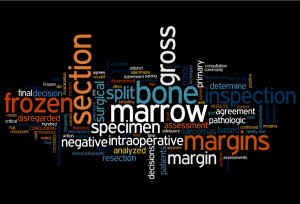
One assessment of tumor margins during bone tumor removal surgery may suffice where two are done now.
Improvements in imaging technologies have made the process of defining the extent of bone tumors like
osteosarcomas increasingly accurate.
But while it’s easier than ever to say, “The tumor starts here and ends here,” when removing a bone tumor surgically, surgeons still need to take a moment during the operation to check the edges (or “margins”) of the removed and remaining bone for any signs of remaining tumor, a step called intraoperative assessment.
“You need to make sure the tumor has been completely removed and a safe amount of normal tissue remains as a buffer,” says Sara Vargas, MD, director of patient safety and quality in Boston Children’s Hospital’s Department of Pathology. “Achieving a margin that is free of tumor reduces a patient’s long-term risk of local tumor recurrence.”
During surgery, there are two ways to do the assessment, each method providing a check on the other: gross split specimen inspection and frozen section inspection.
The two methods, which are often done either simultaneously or in tandem during surgery, are quite different. Full story »

Just like Goldilocks wouldn’t eat porridge that was too hot or too cold, blood vessels won't grow properly in tissues that are too stiff or too loose. (Project Gutenberg/Wikimedia Commons)
In the tale
Goldilocks and the Three Bears, Goldilocks tries all of the bears’ porridge, chairs and beds, finding that only the little bear’s things were just right. Everything else was a little off for her…too hot or too cold, too hard or too soft and so on.
Similarly, for everything to work as it should in the body, things need to be just right. Blood pressure shouldn’t be too high or too low; organs can’t be too big or too small, etc.
Donald Ingber, MD, PhD, and his lab in Boston Children’s Vascular Biology Program take this “just right” approach when thinking about how organs and tissues are structured. Recently, he and a member of his research staff, Akiko Mammoto, MD, PhD, discovered that by changing the stiffness of the surrounding tissues—not too loose and not too tight— they could keep blood vessels from leaking. Their finding could have real consequences for people with sepsis or other diseases featuring leaky vessels. Full story »
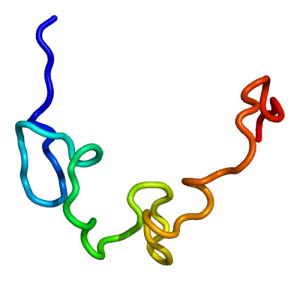
.
Lin28, a known player in cancer, is hard to suppress with drugs. But two related enzymes present highly druggable targets. (Emw/Wikimedia Commons)
Two fundamental processes in biology—stem cell generation and carcinogenesis—are turning out to be closely intertwined. The lab of
Richard Gregory, PhD, has been teasing out this relationship at the molecular level.
In 2008, Gregory and his colleagues showed how a factor called Lin28, which is associated with numerous cancers, makes a cell more prone to revert to a less specialized, stem-like state.
Lin28 acts by preventing maturation of Let-7—an ancient family of microRNAs found in creatures from humans to worms. Let-7 is the yin to Lin28’s yang: it causes stem cells to differentiate (embryonic stem cells, which are completely unspecialized, have very low levels of it). If a cell’s Let-7 can’t mature, it can’t differentiate; instead, it remains stem-like and can potentially become cancerous.
Suppressing Lin28 with RNA interference (RNAi) has been shown to suppress tumor growth. But Lin28 is difficult to target with drugs. Full story »
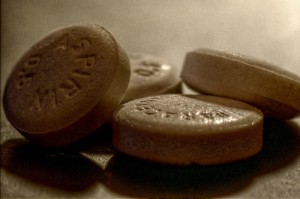
There are a couple of ways by which aspirin might affect cancer. (cpradi/Flickr)
Aspirin does a remarkable number of things in the body, enough that it’s said it would never win approval today from the Food and Drug Administration as an over-the-counter drug.
But among those functions are some that may explain something that doctors have recognized for some time: patients with cancer who have been taking aspirin tend to have better outcomes. Full story »
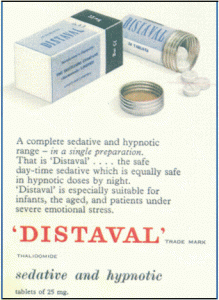
Thalidomide advertisement, c. 1961
In times past, a pharmaceutical chemist’s main focus was to synthesize novel molecules to treat diseases. Today, an increasingly popular alternative is to re-engineer an existing drug—and continually improve it even after FDA approval. That’s how
Robert D’Amato, MD, PhD, developed Pomalyst®, recently
approved to treat multiple myeloma and the most potent analog to date of thalidomide.
 Thalidomide has its own fascinating history. Originally developed by Chemie Grünenthal GmbH in the 1950s, it was the result of a search for an anti-anxiety drug to compete with Valium, and was approved for use in Europe as a sleep aid and depression treatment. Eventually, doctors found it useful for treating nausea, and started prescribing it off-label to pregnant women with morning sickness.
Thalidomide has its own fascinating history. Originally developed by Chemie Grünenthal GmbH in the 1950s, it was the result of a search for an anti-anxiety drug to compete with Valium, and was approved for use in Europe as a sleep aid and depression treatment. Eventually, doctors found it useful for treating nausea, and started prescribing it off-label to pregnant women with morning sickness.
The results were disastrous. Thalidomide turned out to be a teratogen, causing severe birth defects. Full story »

Just about any measurable molecule that changes with health and disease could be a biomarker. (David Guo's Master/Flickr)
Your doctor has a lot of tools to detect, diagnose and monitor disease: x-rays, MRIs, angiography, blood tests, biopsies…the list goes on.
What would be great would be the ability to test for disease in a way where there’s no or low pain (not invasive) and lots of gain (actionable data about the disease process itself, its progression and the success of treatment).
That’s where biomarkers come in. Full story »
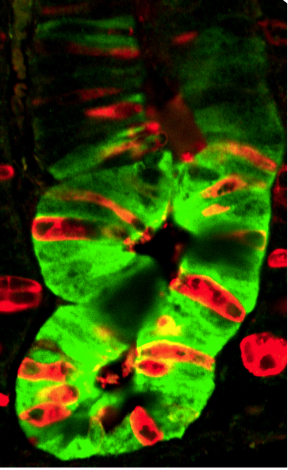
An intestinal crypt enlarged by runaway tissue regeneration. (Courtesy Evan Barry)
We now know a lot about how the process of tissue regeneration gets started, and how to coax that process along to make repairs. But we know little about how to turn regeneration off, which is essential for keeping an organ at a normal size once the repair is complete. Finding that “off” switch may also be the key to halting growth of another kind: cancer.
Along with many other cancer researchers, Fernando Camargo, PhD, a researcher in the Boston Children’s Hospital Stem Cell Program, is hotly focused on a pathway called Hippo that’s known to regulate organ size. One member of this pathway, known as the “yes-associated protein” or YAP, has been found to say “yes” to growth so vigorously that activating it in mice makes the liver quadruple in size, as Camargo showed in 2007. YAP is also thought to be an oncogene, and has become a popular target in liver, ovarian and other cancers.
But Camargo, research fellow Evan Barry, PhD, and their colleagues recently found that saying “no” to YAP might not always be a good idea. Full story »

Transposons, or "jumping" genes, helped our cells evolve, but they might also help cancer develop. (Evil Erin/Flickr)
Our cells’ nuclei aren’t exactly what you’d call calm, quiet places. They’re more like busy city squares, filled with a constant bustle of activity: DNA folds and unfolds, proteins zip in and out to read genes and tag histones and whole chromosomes duplicate themselves while the cell preps for its next round of division.
Now add one more ingredient to this mix: genes that don’t sit still. Our genome is full of what are called transposons, the remnants of ancient viruses that bound themselves within our DNA over evolutionary time. Transposons pretty much do just one thing—copy and insert themselves all over the genome, cutting in on other genes like suitors at a debutantes’ ball.
You might think that having pieces of DNA randomly jumping into and out of genes wouldn’t be a very good thing. And you’d be right: members of Boston Children’s Hospital’s Informatics Program (CHIP) recently reported in Science the first evidence that transposons may directly contribute to the development of some cancers. But the story isn’t that simple. Full story »

Like a seed, a tumor can remain dormant for years. But what's the trigger that causes a tumor to switch from dormancy to aggressive growth? (OpenCage/Flickr)
Believe it or not, you—and I, and everyone around us—quite likely has cancer right now.
While just a third of us will be diagnosed with cancer in our lifetimes, more than 90 percent of us harbor dormant, microscopically small tumors—maybe just a few cells in size—that will never be cause for alarm.
“Most people will live their lives without these tumors growing any larger,” says Randy Watnick, PhD, a researcher in the Vascular Biology Program at Boston Children’s Hospital. “But why? What is the difference between tumors that remain dormant and those destined to grow?”
It’s no small question: As screening and diagnostic technologies improve (allowing us to detect tumors smaller and earlier), the risks of overtreatment rise. That’s fueling a need for better ways to sift potentially dangerous tumors out from ones that will stay quiet. Full story »
 In 2012, Boston Children’s Hospital held the international CLARITY Challenge—an invitation to interpret genomic sequence data from three children with rare diseases and provide a meaningful, actionable report for clinicians and families. (Click for more background on the children, findings and winners.)
In 2012, Boston Children’s Hospital held the international CLARITY Challenge—an invitation to interpret genomic sequence data from three children with rare diseases and provide a meaningful, actionable report for clinicians and families. (Click for more background on the children, findings and winners.)















